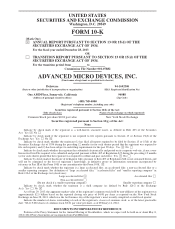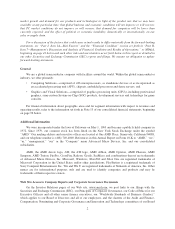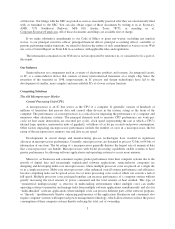AMD 2013 Annual Report Download - page 15
Download and view the complete annual report
Please find page 15 of the 2013 AMD annual report below. You can navigate through the pages in the report by either clicking on the pages listed below, or by using the keyword search tool below to find specific information within the annual report.Graphics and Visual Solutions
Graphics and Visual Solutions Market
A graphics and visual solution can be in the form of an APU, GPU, IGP, SOC or a combination of a GPU
with one of the other foregoing products working in tandem. The semiconductor graphics market addresses the
need for visual or parallel processing in various computing and entertainment platforms such as desktop PCs,
notebooks, tablets and workstations.
APUs deliver visual and parallel processing functionality for value and mainstream PCs, while discrete
GPUs are specifically architected for higher performance graphics processing. A dedicated GPU and CPU
(whether in an APU or as two separate pieces of silicon) work in tandem to increase overall speed and
performance of the system. Users of these graphics products value a rich visual experience to enable a more
compelling and immersive experience. Moreover, for many consumers, the PC is evolving from a traditional data
processing and communications device to an entertainment platform. Visual realism and graphical display
capabilities are key elements of product differentiation among various product platforms. This has led to the
increasing creation and use of processing intensive multimedia content for PCs and to manufacturers designing
PCs for playing games, displaying photos and capturing TV and other multimedia content, viewing online
videos, photo editing and managing digital content. In turn, the trend has continued to contribute to the
development of higher performance graphics solutions.
For many consumers, the PC is evolving from a traditional data processing and communications device to
an entertainment platform. Visual realism and graphical display capabilities are key elements of product
differentiation among various product platforms. This has led to the increasing creation and use of processing
intensive multimedia content for PCs and to manufacturers designing PCs for playing games, displaying photos
and capturing TV and other multimedia content, viewing online videos, editing photos and managing digital
content. In turn, the trend has contributed to the development of higher performance graphics solutions.
Heavy computational workloads have traditionally been processed on a CPU, but we believe that the
industry is shifting to a new computing paradigm that increasingly relies more on the GPU or a combination of
GPU and CPU. AMD Accelerated Parallel Processing or GPGPU (General Purpose GPU) refers to a set of
advanced hardware and software technologies that enable AMD GPUs, working in concert with the computer
system’s CPUs, to accelerate applications beyond traditional graphics and video processing by allowing CPUs
and GPUs to process information cooperatively. Heterogeneous computing, which refers to computer systems
that use more than one kind of processor, enables PCs and servers to run computationally-intensive tasks more
efficiently, which we believe provides a superior application experience to the end user.
Graphics and Visual Solutions Products
Our customers generally use our graphics and visual solutions to increase the speed of rendering images and
to improve image resolution and color definition. We develop our products for use in desktop PCs, notebooks,
tablets, professional workstations, servers and gaming consoles. In addition, our semi-custom products are
tailored, high-performance customer-specific solutions based on AMD’s CPU, GPU and APU technology. We
work closely together with our customers to define solutions with a selectable level of GPU performance to
precisely match the requirements of the device or application. Approaches range from complex, full-custom
SOCs to more modest adaptations and integrations of existing parts.
With each of our graphics products, we have available drivers and supporting software packages that enable
the effective use of these products under a variety of operating systems and applications. In addition, our recent
generation graphics products have Linux®driver support.
Game Consoles.We have leveraged our core graphics and visual processing technologies developed for
the PC market by providing graphic and visual solutions to game console manufacturers. In this market,
7
























